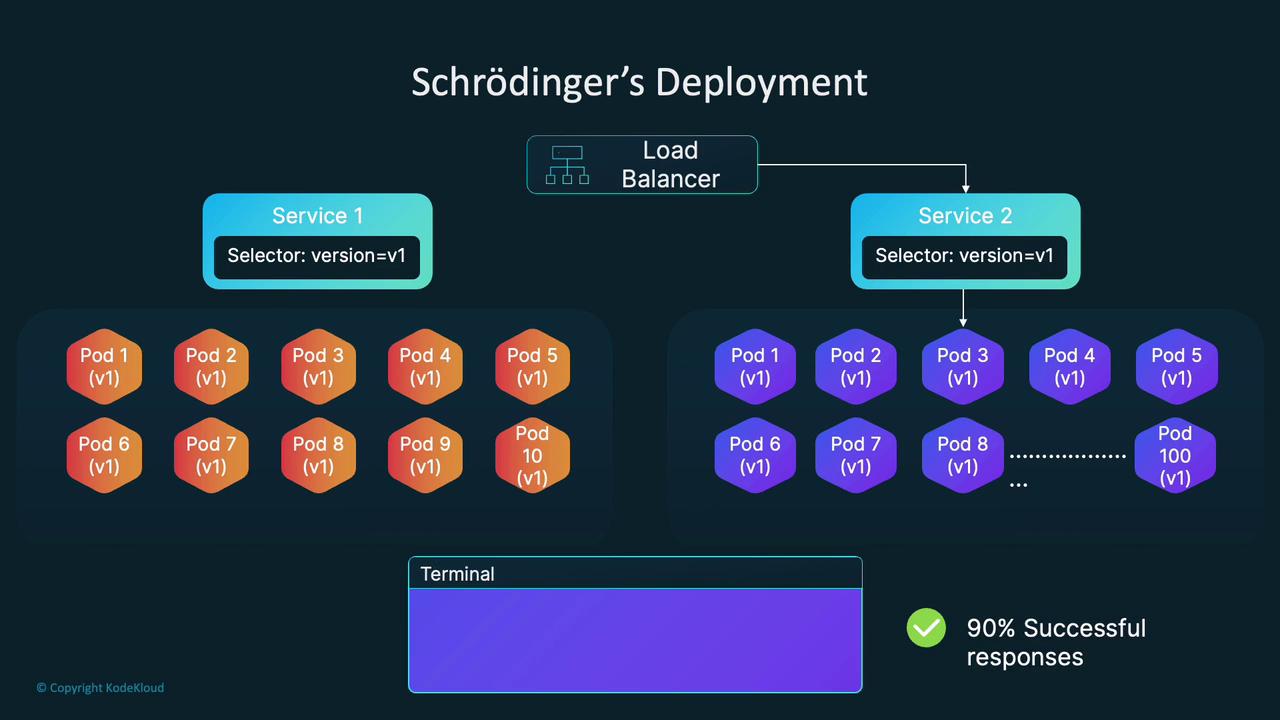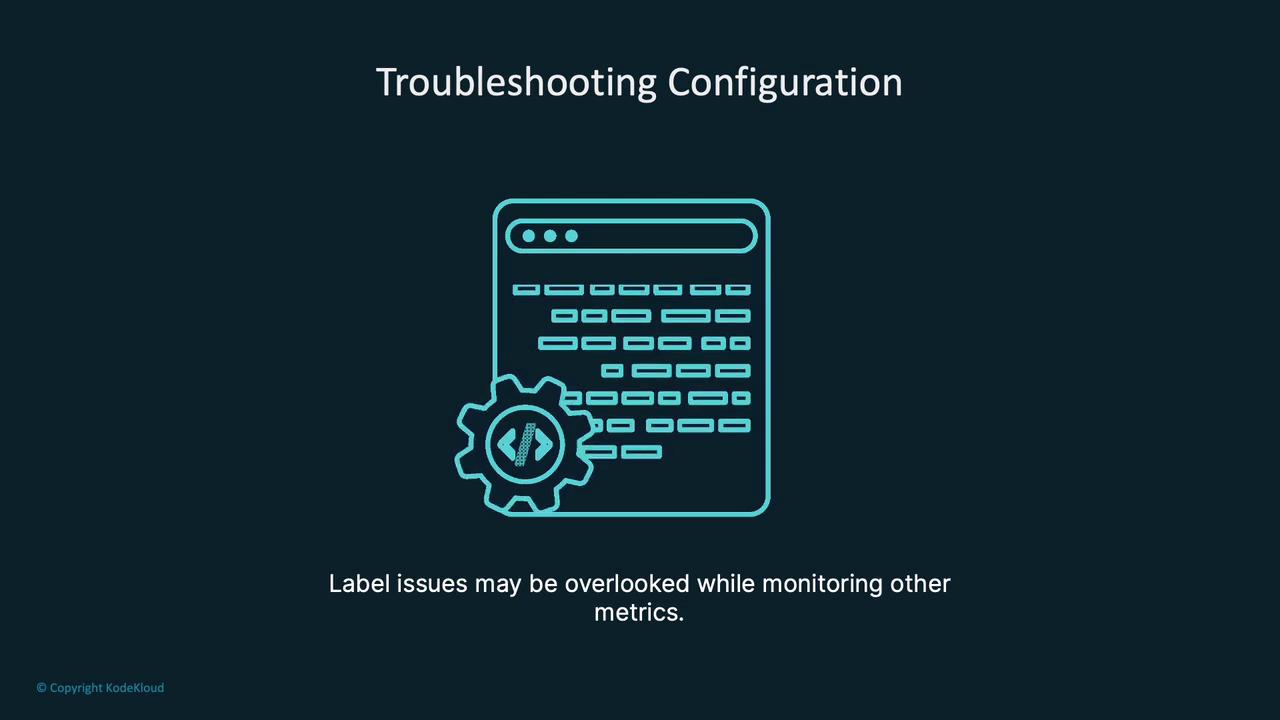Kubernetes Troubleshooting for Application Developers
Troubleshooting Scenarios
Schrodingers Deployment
Welcome to this lesson on troubleshooting a peculiar behavior in Kubernetes deployments. In this guide, we will explore why our blue service sometimes returns responses from the green application. Let’s dive in.
Observing the Problem
When inspecting the cluster, both the blue and green deployments are running as expected. The following command output confirms this:
controlplane ~ ➜ k get all
NAME READY STATUS RESTARTS AGE
pod/blue-6c7b7b965f-8vxwp 1/1 Running 0 21m
pod/blue-6c7b7b965f-zddzq 1/1 Running 0 24m
pod/green-864c4d957c-tnq9r 1/1 Running 0 24m
pod/green-864c4d957c-w7ktb 1/1 Running 0 93s
NAME TYPE CLUSTER-IP EXTERNAL-IP PORT(S) AGE
service/blue-service NodePort 10.98.48.50 <none> 8080:30102/TCP 24m
service/green-service NodePort 10.107.193.230 <none> 8080:30101/TCP 24m
service/kubernetes ClusterIP 10.96.0.1 <none> 443/TCP 46m
NAME READY UP-TO-DATE AVAILABLE AGE
deployment.apps/blue 2/2 2 2 24m
deployment.apps/green 2/2 2 2 24m
NAME DESIRED CURRENT READY AGE
replicaset.apps/blue-6c7b7b965f 2 2 2 24m
replicaset.apps/green-864c4d957c 2 2 2 24m
controlplane ~ ➜
The blue service is expected to serve a blue screen, while the green service serves a green screen using a basic web server. When accessing the green service in your browser, each refresh may hit a different replica due to load balancing across multiple pods.
However, upon accessing the blue service endpoint repeatedly, you may notice an unexpected mix of responses that sometimes include a green background.
Investigating Service Definitions
To diagnose the issue, let's review the service definitions.
Current Cluster State
The initial output of our cluster services is as follows:
controlplane ~ ➜ k get all
NAME READY STATUS RESTARTS AGE
pod/blue-6c7b7b965f-8vxwp 1/1 Running 0 21m
pod/blue-6c7b7b965f-zddzq 1/1 Running 0 24m
pod/green-864c4d957c-tnq7r 1/1 Running 0 24m
pod/green-864c4d957c-w7ktb 1/1 Running 0 93s
NAME TYPE CLUSTER-IP EXTERNAL-IP PORT(S) AGE
service/blue-service NodePort 10.98.48.50 <none> 8080:30102/TCP 24m
service/green-service NodePort 10.107.193.230 <none> 8080:30101/TCP 24m
service/kubernetes ClusterIP 10.96.0.1 <none> 443/TCP 46m
NAME READY UP-TO-DATE AVAILABLE AGE
deployment.apps/blue 2/2 2 2 24m
deployment.apps/green 2/2 2 2 24m
NAME DESIRED CURRENT READY AGE
replicaset.apps/blue-6c7b7b965f 2 2 2 24m
replicaset.apps/green-864c4d957c 2 2 2 24m
controlplane ~ ➜
Listing Service Definition Files
The two service configuration files in the directory are:
controlplane ~ ➜ ls
blue-svc.yaml green-svc.yaml
blue-svc.yaml
apiVersion: v1
kind: Service
metadata:
name: blue-service
spec:
type: NodePort
selector:
version: v1
ports:
- port: 8080
targetPort: 8080
nodePort: 30102
green-svc.yaml
apiVersion: v1
kind: Service
metadata:
name: green-service
spec:
type: NodePort
selector:
version: v1
app: green
ports:
- port: 8080
targetPort: 8080
nodePort: 30101
The green service’s selector uses both version: v1 and app: green, isolating the green pods properly. The blue service, however, only uses version: v1 as its selector. Since both blue and green pods share the version: v1 label, the blue service unintentionally selects green pods too, leading to mixed responses.
Understanding Label Selectors and Endpoints
Kubernetes services route traffic to all pods matching their label selectors. To verify the selected pods for label version=v1, run:
controlplane ~ ➜ k get pods -l version=v1
NAME READY STATUS RESTARTS AGE
blue-6c7b7b965f-8xwp 1/1 Running 0 30m
blue-6c7b7b965f-zddzq 1/1 Running 0 33m
green-864c4d957c-tnq9r 1/1 Running 0 33m
green-864c4d957c-w7ktb 1/1 Running 0 10m
Checking the endpoints for each service further clarifies the issue:
controlplane ~ ➜ k get endpoints
NAME ENDPOINTS AGE
blue-service 10.244.1.2:8080,10.244.1.3:8080,10.244.1.4:8080 + 1 more... 34m
green-service 10.244.1.2:8080 34m
kubernetes 192.147.9.6:6443 56m
Notice that the blue service includes endpoints for both blue and green pods, whereas the green service correctly targets only green pods.
Tip
Use the command "k edit svc blue-service" to inspect and modify the blue service configuration in real time.
Fixing the Issue
To ensure that the blue service routes traffic only to blue pods, update the blue service selector by adding a unique label. Modify the selector to include both version: v1 and app: blue. After making this change, the blue service will exclusively target blue pods.
Once updated, verify the endpoints again:
controlplane ~ ➜ k get endpoints
NAME ENDPOINTS AGE
blue-service 10.244.1.2:8080,10.244.1.4:8080 35m
green-service 10.244.1.3:8080 35m
kubernetes 192.147.9.6:6443 57m
This confirmation shows that the blue service now exclusively routes requests to the correct blue pods, resolving the intermittent misrouting issue.
Final Thoughts
This troubleshooting exercise highlights the critical importance of using unique labels in Kubernetes deployments. Overlapping selectors can cause unexpected behavior and intermittent failures that are challenging to diagnose in large-scale environments.
Understanding how label selectors, service endpoints, and load balancing interact is vital for maintaining reliable application deployments in Kubernetes.

Even if the application appears to work correctly most of the time, such misconfigurations can lead to intermittent issues that are hard to catch during routine monitoring.

Having a robust troubleshooting process, including verifying service endpoints and label selectors, is essential for diagnosing and resolving configuration issues in Kubernetes.
![]()
Happy troubleshooting, and see you in the next lesson!
Watch Video
Watch video content